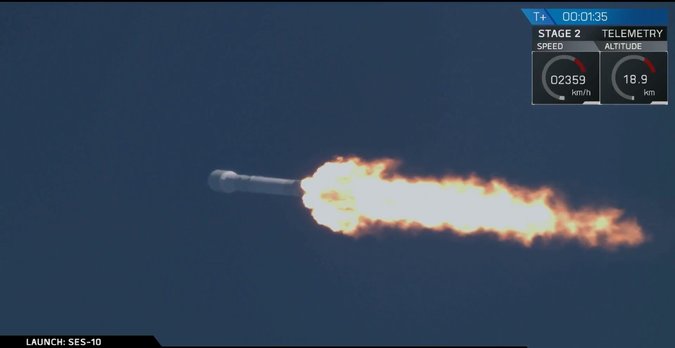SpaceX, the commercial spaceflight company that has made repeated headlines in recent years for garnering NASA contracts to ferry equipment, and soon people, to and from the International Space Station made history once again on Thursday; this time for being the first private organization to re-launch a previously used orbital rocket.
The first stage of SpaceX’s Thursday SES-10 mission rocket has already made the trip to orbit as part of the CRS-8 mission in April of 2016. The stage then returned to earth safely, landing aboard a drone ship at sea. The retrieval of the rocket stage took place on April 8th; with the vertical landing accomplished using boosters that allow for a very science-fiction looking show.
Thursday’s mission lifted off from Kennedy Space Center in Florida carrying a payload that included a telecommunications satellite that, once in proper orbit, will service Latin America. The re-used booster stage then returned once again, safely landing aboard a drone platform in the Atlantic Ocean – ready to be recovered, and feasibly used again on later missions.
“It did this mission perfectly,” Mr. Musk said during a SpaceX broadcast of the launch. “It dropped off the second stage, came back and landed on the drone ship. Right in the bulls-eye.”
“It means you can fly and refly an orbital class booster, which is the most expensive part of the rocket,” he added.
The development of reusable rockets could dramatically reduce the cost of ferrying gear and personnel to orbit – a task that currently uses the rule of thumb of approximately $10,000 per pound – making the trip prohibitively expensive for all but national governments and a select few private companies intent on commercializing the “final frontier.” According to Musk, the resource and monetary cost of not being able to reuse rocket sections is comparable to “scrapping a 747 jet” for each mission. By reducing the cost of each launch through reusable rockets, SpaceX hopes to open new doors for all sorts of commercial, government, and private ventures beyond the reach of Earth’s gravity (or at least where its grip isn’t so tight).
For Elon Musk, the man responsible for such businesses as SpaceX, Tesla, and a new company intent on linking the brains of human beings to computers, among others, reducing the costs associated with rocket launches brings him one step closer to his long-term goal of sending a manned mission to Mars – a goal paralleled by NASA under President Trump’s recent budget approval.
NASA’s previous workhorse, the space shuttle, was intended to curb the costs of space flight by reusing the crew cabin and recovered engines referred to as SSMEs. New fuel tanks for each launch combined with the overall cost of maintaining the shuttles, however, eventually led to a whopping $450 million dollar price tag for each and every space shuttle mission.
By comparison, a “capabilities and services” chart released by SpaceX places current price points for launch at a measly (by comparison) $62 million for a Falcon 9, and $90 million for the larger Falcon Heavy. These price points were determined without cost savings factored in for reusing rocket stages, which Musk estimates could drop each of these prices by as much as thirty percent, meaning Falcon 9 launches like Thursday’s mission could soon ring in at a budget conscious $44 million dollars – less than a tenth of each shuttle mission.
“They’ve taken the right first steps,” said Daniel Dumbacher, a former NASA official who is now a professor at Purdue University. “This is where you just have to get out and do it.”
Watch SpaceX rocket stages vertical landing capabilities below:
Already have an account? Sign In
Two ways to continue to read this article.
Subscribe
$1.99
every 4 weeks
- Unlimited access to all articles
- Support independent journalism
- Ad-free reading experience
Subscribe Now
Recurring Monthly. Cancel Anytime.
Image courtesy of SpaceX









